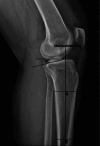Association of Posterior Tibial Slope and Functional Outcome After Total Knee Arthroplasty: An Observational Study
- PMID: 39712763
- PMCID: PMC11663243
- DOI: 10.7759/cureus.74201
Association of Posterior Tibial Slope and Functional Outcome After Total Knee Arthroplasty: An Observational Study
Abstract
Introduction Precise implant positioning, particularly a well-balanced posterior tibial slope (PTS), is crucial for the success of total knee arthroplasty (TKA) because it enhances sagittal plane stability and significantly influences knee motion patterns. The long-term impact of tibial slope on active and passive range of motion (ROM) still needs to be studied, despite ROM's crucial role in patient contentment. This study examined the relationship between tibial slope and active and passive ROM following TKA, with a follow-up period of at least three months. Materials and methods The study included 40 knees of 30 participants who had undergone initial TKA for knee osteoarthritis (KOA). These subjects were recruited between September 2023 and May 2024, with a minimum postoperative follow-up period of three months. Results Significant improvements in the average Kujala score and knee ROM were observed at postop day 7 and at the three-month follow-up as compared to preoperative measurements (p<0.001). Concurrently, there was a notable decrease in the mean posterior tibial slope (PTS) angle (p<0.001). While patients with a larger PTS angle exhibited higher average Kujala scores and knee ROM, the correlations between these variables and the PTS angle were not statistically significant. Conclusion Considering its limitations, this research indicates that the posterior tibial slope does not significantly affect the functional outcomes of patients after primary total knee replacement in the initial treatment phase.
Keywords: knee osteoarthritis (koa); knee range of motion (rom); kujala score; pts (posterior tibial score); tka (total knee arthroplasty).
Copyright © 2024, Singh et al.
Conflict of interest statement
Human subjects: Consent for treatment and open access publication was obtained or waived by all participants in this study. Institutional Ethics Committee, KGMU issued approval XIX-PGTSC-IIA/P42. Animal subjects: All authors have confirmed that this study did not involve animal subjects or tissue. Conflicts of interest: In compliance with the ICMJE uniform disclosure form, all authors declare the following: Payment/services info: All authors have declared that no financial support was received from any organization for the submitted work. Financial relationships: All authors have declared that they have no financial relationships at present or within the previous three years with any organizations that might have an interest in the submitted work. Other relationships: All authors have declared that there are no other relationships or activities that could appear to have influenced the submitted work.
Figures



Similar articles
-
Cementless, Cruciate-Retaining Primary Total Knee Arthroplasty Using Conventional Instrumentation: Technical Pearls and Intraoperative Considerations.JBJS Essent Surg Tech. 2024 Sep 13;14(3):e23.00036. doi: 10.2106/JBJS.ST.23.00036. eCollection 2024 Jul-Sep. JBJS Essent Surg Tech. 2024. PMID: 39280965 Free PMC article.
-
Similar Midterm Outcomes of Total Knee Arthroplasties with Anterior and Posterior Tibial Slopes Performed on Paired Knees at a Minimum Follow-up of 5 Years.J Knee Surg. 2024 Mar;37(4):310-315. doi: 10.1055/a-2094-8728. Epub 2023 May 16. J Knee Surg. 2024. PMID: 37192660
-
Reproducing the Native Posterior Tibial Slope in Cruciate-Retaining Total Knee Arthroplasty: Technique and Clinical Implications.Orthopedics. 2020 Jan 1;43(1):e21-e26. doi: 10.3928/01477447-20191122-06. Epub 2019 Nov 26. Orthopedics. 2020. PMID: 31770448
-
Effect of Posterior Tibial Slope Change on Postoperative Range of Motion and Clinical Outcomes after Posterior Cruciate-Substituting Total Knee Arthroplasty.J Knee Surg. 2023 Jan;36(1):87-94. doi: 10.1055/s-0041-1729967. Epub 2021 May 15. J Knee Surg. 2023. PMID: 33992035
-
[Analysis of the influence of tibial component posterior slope angle on short- and mid-term effectiveness of unicompartmental knee arthroplasty].Zhongguo Xiu Fu Chong Jian Wai Ke Za Zhi. 2022 Feb 15;36(2):189-195. doi: 10.7507/1002-1892.202110019. Zhongguo Xiu Fu Chong Jian Wai Ke Za Zhi. 2022. PMID: 35172404 Free PMC article. Chinese.
References
-
- The effect of tibial slope angle on clinical and functional results after mobile bearing total knee arthroplasty. Adıyeke L, Kafadar AB, Erdoğan Ö, Gündüz ÇD. J Orthop Trauma Rehabil. 2022;1:29.
-
- Effects of increasing tibial slope on the biomechanics of the knee. Giffin JR, Vogrin TM, Zantop T, Woo SL, Harner CD. https://doi.org/10.1177/0363546503258880. Am J Sports Med. 2004;32:376–382. - PubMed
-
- Effect of posterior tibial slope on knee biomechanics during functional activity. Shelburne KB, Kim HJ, Sterett WI, Pandy MG. J Orthop Res. 2011;29:223–231. - PubMed
-
- High tibial osteotomy in the ACL-deficient knee with medial compartment osteoarthritis. Herman BV, Giffin JR. https://doi.org/10.1007/s10195-016-0413-z. J Orthop Traumatol. 2016;17:277–285. - PMC - PubMed
LinkOut - more resources
Full Text Sources
